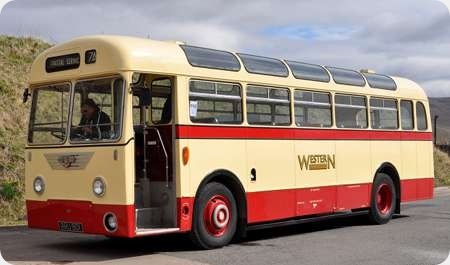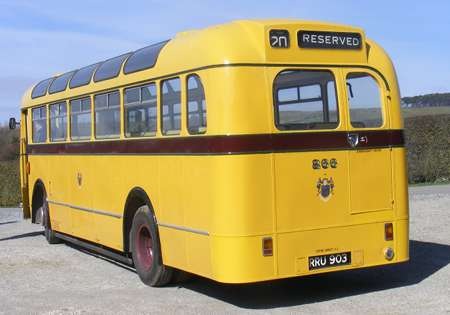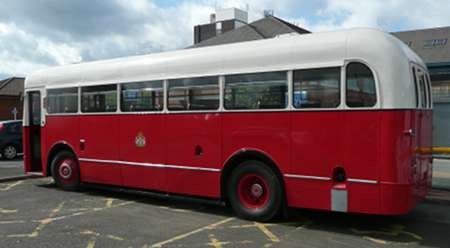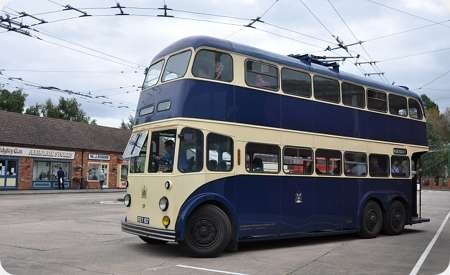
Rotherham Corporation
1950
Daimler CTE6
Roe H40/30R
FET 617 is a Daimler CTE6 of 1950, once in the fleet of Rotherham Corporation. Originally it had an East Lancs B38C body but in 1956 it was re-bodied by Roe to H40/30R and at the same time it was renumberd from 17 to 37. It was one of the last trolleybuses to be withdrawn in 1965 when the Rotherham system closed down.
She’s seen on duty at the trolleybus museum at Sandtoft which, although it is noted as being near Doncaster, is actually just over the border in the part of Lincolnshire which was in Humberside for a while. She’s turning in the area between the depot and the parade of shops.
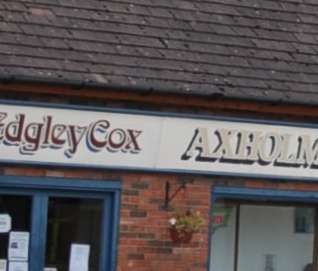
Note the reference on one shop front to a Transport General Manager who has been mentioned before in these columns! The photograph was taken on 30th August 2009, Bank Holiday Monday.
Photograph and Copy contributed by Pete Davies
28/05/15 – 06:30
Back in 1971 I was part of a small team that dragged this vehicle over the hills and moors to join in the HCVS Trans Pennine Run. One of my photos from the weekend features on my Flickr page. https://flic.kr/p/c5jjjN
Berisford Jones
29/05/15 – 07:55
As this was rebodied in 1956 when 3Oft twin axle double deckers were legal and were being built with five bay construction, I wonder why what was becoming an anachronistic six bay layout was chosen.
Phil Blinkhorn
30/05/15 – 06:59
Lovely photo Pete.
Berisford. That was some journey, which must have been boring for whoever steered the ‘bus! It reminds me of all the ‘dead’ trolleybus movements which took place during the war all over the country.
Chris Hebbron
30/05/15 – 06:59
These Rotherham rebodies were very similar to the 70-seater Roe bodies on Karrier chassis for Huddersfield that were delivered just a few years earlier, which were also six-bay construction. The Huddersfield examples had the standard Roe waistrail though, while the Rotherham ones didn’t; the ‘poor man’s Roe body’, as a friend of mine likes to call it! Rotherham also saved some pennies by reusing the seats, where possible, from the scrapped single-deckers in the lower saloons of these new Roe bodies.
When I was a kid growing up in Rotherham, I was fascinated with the corporation trolleybuses, though I don’t recall ever seeing one operating with the windscreen open the way 37’s is here! Rotherham just never seemed to get even close to warm enough for that to happen in those days!
Dave Careless
30/05/15 – 09:22
It’s called global warming, Dave. We don’t seem to have had that in our youth!
Pete Davies
30/05/15 – 18:05
Warming? Not right now! The story of these Rotherham tracklesses (as the dedicated site correctly calls them) is fascinating. The single deckers gave a continental atmosphere to Rotherham!
Was the opening windscreen really for fog? I remember that Austin 10’s had this too.
Joe
30/05/15 – 18:06
So Dave, it was a case of Yorkshire tight fistedness, or what my Huddersfield born brother in law would call "being careful with t’brass"
Phil Blinkhorn
31/05/15 – 06:45
I don’t think they had a lot of choice, really, Phil, but to be watching the pennies at the time. Those 44 Daimler single-deckers that the corporation bought in 1949-50 apparently represented a quarter of a million pounds worth of investment, and by 1954, only four years later, after the conversion of the Maltby route to motor buses, they only had work for 36 of them, the other eight having already been delicensed and advertised for sale, for which at the time there were no takers.
The General Manager, I.O. Fisher, who took over from Norman Rylance who had unfortunately passed away in December 1954, presented a report to the Transport Committee in July, 1955, in which he informed them that each of the fleet of single-deckers required approx. 850 pounds worth of work to put them into ‘first-class’ condition, which amounted to something like 37,400 pounds in total, which would have been yet another significant investment. Fisher estimated that rebodying 14 of the chassis with double-deck bodies to start with would cost somewhere in the region of 32,000 pounds, and operating double-deckers would then allow him to reduce frequencies and thus reduce the number of crews required, and still have more seats available on the main trolleybus service that he considered converting to double-deck first. The Transport Committee agreed that Fisher’s idea seemed to be the most favourable option, and I guess the rest is history.
In the end, twenty chassis were rebodied as double-deckers by February 1957, eight were retained in service as single-deckers until March 1961, for the jointly operated services with Mexborough and Swinton, and one was prematurely scrapped, presumably for spares, which left fifteen delicensed single-deckers in the Rotherham depot for several years, covered in grime and looking very dejected, until eventually they were sold for further service in Spain in 1960, for the princely sum of 1,133 pounds each! Two of the eight that had been retained for the Mexborough work also joined their sisters in Spain a year later, these two only fetching 1,000 pounds each at sale, and the remaining six eventually ended up in the breakers yard, sold to Autospares of Bingley, and a steal at a mere 66 pounds apiece!
In the end, Fisher’s decision to rebody the uneconomical 38-seaters meant that the corporation at least got their money’s worth out of twenty of the vehicles that they’d been so proud of just a few years before. They certainly got their value out of those original moquette seats anyway, if nothing else!!
Dave Careless
31/05/15 – 06:46
I believe opening windscreens were originally to do with fog as you say Joe, and were a legal requirement. I’m not sure when the practice of fitting them ended, or when the legislation changed, but looking at ECW as an example, the new MW coach body introduced in 1962 had fixed rubber mounted windscreens. However, the Lodekka continued with an opening windscreen until, from memory 1966, when rubber-mounted screens became the standard. With the Lodekka opening windscreen, the wiper motor spindle came through the top edge of the metal surround, whereas with the rubber-mounted screen the spindle came through the bodywork above the screen. Funny the little things we remember isn’t it?
Brendan Smith
01/06/15 – 07:24
That, Dave, is what can only be called a fascinating piece of transport and social history. Thanks for taking the time to relate it.
Brendan, the change in Construction and Use to allow fixed windscreens on PSVs was promulgated in 1957. There had to be demisting equipment so many operators continued to specify opening windscreens. There was a halfway house that had been around for some years prior to 1957, being a single piece windscreen hinged at the top which a number of body builders offered on their double deckers.
Phil Blinkhorn
02/06/15 – 07:10
Thanks, Phil, I’m glad you enjoyed it. I can still remember my father, after his usual pre-Sunday dinner excursion to the ‘Shakespeare Hotel’, telling me that he’d seen a Doncaster trolleybus running along Fitzwilliam Road in Rotherham. I was seven at the time, and naturally went tearing off down there, about half a mile away, in the hopes of seeing it myself, which unfortunately I didn’t. Obviously, the borrowing of the Doncaster Karrier that day, June 19th, 1955, turned out to be a pivotal moment for the corporation, Fisher wanting to be absolutely sure that there would be nothing unforeseen to prevent double-deck trolleybus operation in the town before presenting his ideas to the Transport Committee the following month.
What I find fascinating is that we’re still enjoying reading and writing about such events, almost exactly sixty years later! Sadly, although it’s been fifty years since the Rotherham trolleys disappeared for good, I can’t even imagine a seven year old being allowed to wander off that far from home in the hopes of catching sight of one in the enlightened world we inhabit today.
Dave Careless
02/06/15 – 07:11
Thanks for that Phil. The change in legislation took place earlier than I’d thought. BVB3
Brendan Smith
03/06/15 – 06:25
As an afterthought to my post yesterday relating how my father had witnessed the Doncaster Karrier running ‘on test’ under Rotherham wires in June 1955, apparently the Karrier was driven as far as Balby terminus, the southernmost part of the Doncaster network, where it was hooked up to the Rotherham Bristol towing wagon that had been despatched to fetch it to Rotherham, it being towed along the A630 as far as the nearest point on the corporation’s wires at the Thrybergh terminus. Intriguingly, with respect to the ‘opening windscreens’ discussion, the old Bristol wagon, a full-fronted machine, had both windscreens open by the time it got to Thrybergh, being well ‘on the boil’ after dragging the six-wheeler the nine miles or so from Balby!!
Luckily, Doncaster enthusiast Geoff Warnes, a mere teenager back then, got wind of the event, and followed the convoy on his bicycle, taking his camera with him, and recording the activities for posterity as the Karrier was ‘trialled’ from Thrybergh to Kimberworth and around the town centre, as well as to and from the depot, with a tower wagon in attendance in case of problems. Story has it that although he was present himself at the Rawmarsh Road garage, Rotherham’s general manager had forgotten to arrange to have a photographer on hand to record the event, and seeing Geoff with his camera, I.O. Fisher invited him into the depot to photograph the scene.
Sad to report that Geoff Warnes passed away just a few weeks ago, but due to his foresight that Sunday morning, we do have pictures of the event that led to Rotherham running double-deck trolleybuses for the last decade or so of electric traction in the town.
Dave Careless
03/06/15 – 15:26
In terms of Yorkshire canniness Doncasters reuse of trolley bus bodies on motor chassis must take some beating!
On the subject of towed trolleybuses I was on the M1 heading north in 1970 and stopped at Woodhall services. In the parking area was Bradford 558 an all Leyland PD2 being used to tow former Nottingham Karrier 493 to the Sandtoft Museum I bet that caused other road users a few headaches.
Chris Hough
04/06/15 – 06:24
Chris- not only (new) motor bus chassis, but old trolley bus bodies rebodying old motor bus chassis too! Bodies which had rebodied trolleybuses were used to rebody motor bus chassis of similar age to the original trolley chassis. (still with me?)
Joe

